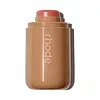What's inside
What's inside
 Key Ingredients
Key Ingredients

 Benefits
Benefits

 Concerns
Concerns

 Ingredients Side-by-side
Ingredients Side-by-side

Octyldodecanol
EmollientSynthetic Wax
AbrasiveHydrogenated Polyisobutene
EmollientCetyl Ethylhexanoate
EmollientPolyglyceryl-2 Triisostearate
EmulsifyingHydrogenated Poly(C6-14 Olefin)
EmollientBis-Diglyceryl Polyacyladipate-2
EmollientKaolin
AbrasiveSilica
AbrasiveMagnesium/Potassium/Silicon/Fluoride/Hydroxide/Oxide
Glycerin
HumectantCalophyllum Inophyllum Seed Oil
AntimicrobialPalmitoyl Tripeptide-1
Skin ConditioningPalmitoyl Tripeptide-5
Skin ConditioningCaprylyl Glycol
EmollientCaprylic/Capric Triglyceride
MaskingGlyceryl Caprylate
EmollientPentaerythrityl Tetraisostearate
EmollientAluminum Hydroxide
EmollientTriethoxycaprylylsilane
Water
Skin ConditioningPropylene Carbonate
SolventLauryl Polyglyceryl-3 Polydimethylsiloxyethyl Dimethicone
Skin ConditioningStearalkonium Hectorite
Gel FormingEthylhexylglycerin
Skin ConditioningCI 77891
Cosmetic ColorantIron Oxides
CI 15850
Cosmetic ColorantOctyldodecanol, Synthetic Wax, Hydrogenated Polyisobutene, Cetyl Ethylhexanoate, Polyglyceryl-2 Triisostearate, Hydrogenated Poly(C6-14 Olefin), Bis-Diglyceryl Polyacyladipate-2, Kaolin, Silica, Magnesium/Potassium/Silicon/Fluoride/Hydroxide/Oxide, Glycerin, Calophyllum Inophyllum Seed Oil, Palmitoyl Tripeptide-1, Palmitoyl Tripeptide-5, Caprylyl Glycol, Caprylic/Capric Triglyceride, Glyceryl Caprylate, Pentaerythrityl Tetraisostearate, Aluminum Hydroxide, Triethoxycaprylylsilane, Water, Propylene Carbonate, Lauryl Polyglyceryl-3 Polydimethylsiloxyethyl Dimethicone, Stearalkonium Hectorite, Ethylhexylglycerin, CI 77891, Iron Oxides, CI 15850
Water
Skin ConditioningMethyl Trimethicone
Skin ConditioningDimethicone
EmollientCetyl Ethylhexanoate
EmollientIsononyl Isononanoate
EmollientAlcohol Denat.
AntimicrobialPolybutene
Polypropylsilsesquioxane
Butylene Glycol
HumectantGlycerin
HumectantPEG-10 Dimethicone
Skin ConditioningPentylene Glycol
Skin ConditioningVinyl Dimethicone/Methicone Silsesquioxane Crosspolymer
1,2-Hexanediol
Skin ConditioningChlorella Vulgaris Extract
Skin ConditioningPrunus Armeniaca Fruit Extract
Skin ConditioningSodium Hyaluronate
HumectantDisteardimonium Hectorite
StabilisingMagnesium Sulfate
Bis-Diglyceryl Polyacyladipate-2
EmollientCetyl PEG/PPG-10/1 Dimethicone
EmulsifyingGlucose
HumectantFructooligosaccharides
HumectantFructose
HumectantEthylhexylglycerin
Skin ConditioningTrisodium Ethylenediamine Disuccinate
Triethoxycaprylylsilane
Panthenol
Skin ConditioningAluminum Hydroxide
EmollientPentaerythrityl Tetra-Di-T-Butyl Hydroxyhydrocinnamate
AntioxidantTocopherol
AntioxidantCI 77891
Cosmetic ColorantCI 77492
Cosmetic ColorantMica
Cosmetic ColorantCI 77491
Cosmetic ColorantCI 73360
Cosmetic ColorantCI 77007
Cosmetic ColorantIron Oxides
Water, Methyl Trimethicone, Dimethicone, Cetyl Ethylhexanoate, Isononyl Isononanoate, Alcohol Denat., Polybutene, Polypropylsilsesquioxane, Butylene Glycol, Glycerin, PEG-10 Dimethicone, Pentylene Glycol, Vinyl Dimethicone/Methicone Silsesquioxane Crosspolymer, 1,2-Hexanediol, Chlorella Vulgaris Extract, Prunus Armeniaca Fruit Extract, Sodium Hyaluronate, Disteardimonium Hectorite, Magnesium Sulfate, Bis-Diglyceryl Polyacyladipate-2, Cetyl PEG/PPG-10/1 Dimethicone, Glucose, Fructooligosaccharides, Fructose, Ethylhexylglycerin, Trisodium Ethylenediamine Disuccinate, Triethoxycaprylylsilane, Panthenol, Aluminum Hydroxide, Pentaerythrityl Tetra-Di-T-Butyl Hydroxyhydrocinnamate, Tocopherol, CI 77891, CI 77492, Mica, CI 77491, CI 73360, CI 77007, Iron Oxides
 Reviews
Reviews

Ingredients Explained
These ingredients are found in both products.
Ingredients higher up in an ingredient list are typically present in a larger amount.
Aluminum Hydroxide is a form of aluminum. It can be naturally found in nature as the mineral gibbsite. In cosmetics, Aluminum Hydroxide is used as a colorant, pH adjuster, and absorbent.
As a colorant, Aluminum Hydroxide may add opacity, or reduce the transparency. Aluminum hydroxide is contains both basic and acidic properties.
According to manufacturers, this ingredient is an emollient and humectant. This means it helps hydrate the skin.
In medicine, this ingredient is used to help relieve heartburn and help heal ulcers.
There is currently no credible scientific evidence linking aluminum hydroxide in cosmetics to increased cancer risk.
Major health organizations allow the use of aluminum hydroxide in personal care products and have not flagged it as a carcinogenic risk at typical usage levels.
Learn more about Aluminum HydroxideThis ingredient is lipid-based synthetic skin-conditioning agent derived from adipic acid and a mixture of fatty acids. It is often called a lanolin substitute.
As an emollient, it helps soften and hydrate the skin. Emollients create a barrier on the skin to trap moisture in.
Due to its fatty acid base, it may not be Malassezia folliculitis safe.
Learn more about Bis-Diglyceryl Polyacyladipate-2Cetyl Ethylhexanoate is an emollient ester. It comes from cetearyl alcohol and 2-ethylhexanoic acid.
Cetyl Ethylhexanoate is an emollient that adds a velvety feel to skin without being greasy or oily. Emollients help trap moisture into your skin, keeping your skin soft and hydrated.
Ci 77891 is a white pigment from Titanium dioxide. It is naturally found in minerals such as rutile and ilmenite.
It's main function is to add a white color to cosmetics. It can also be mixed with other colors to create different shades.
Ci 77891 is commonly found in sunscreens due to its ability to block UV rays.
Learn more about CI 77891Ethylhexylglycerin (we can't pronounce this either) is commonly used as a preservative and skin softener. It is derived from glyceryl.
You might see Ethylhexylglycerin often paired with other preservatives such as phenoxyethanol. Ethylhexylglycerin has been found to increase the effectiveness of these other preservatives.
Glycerin is already naturally found in your skin. It helps moisturize and protect your skin.
A study from 2016 found glycerin to be more effective as a humectant than AHAs and hyaluronic acid.
As a humectant, it helps the skin stay hydrated by pulling moisture to your skin. The low molecular weight of glycerin allows it to pull moisture into the deeper layers of your skin.
Hydrated skin improves your skin barrier; Your skin barrier helps protect against irritants and bacteria.
Glycerin has also been found to have antimicrobial and antiviral properties. Due to these properties, glycerin is often used in wound and burn treatments.
In cosmetics, glycerin is usually derived from plants such as soybean or palm. However, it can also be sourced from animals, such as tallow or animal fat.
This ingredient is organic, colorless, odorless, and non-toxic.
Glycerin is the name for this ingredient in American English. British English uses Glycerol/Glycerine.
Learn more about GlycerinTriethoxycaprylylsilane is a silicone used to bind and stabilize ingredients.
As an emulsifier, it helps prevent ingredients from separating. This can help elongate the shelf life of products.
Triethoxycaprylylsilane is often used to coat mineral sunscreens ingredients to help give a better feel. It also helps reduce oxidative stress in sunscreens.
Learn more about TriethoxycaprylylsilaneWater. It's the most common cosmetic ingredient of all. You'll usually see it at the top of ingredient lists, meaning that it makes up the largest part of the product.
So why is it so popular? Water most often acts as a solvent - this means that it helps dissolve other ingredients into the formulation.
You'll also recognize water as that liquid we all need to stay alive. If you see this, drink a glass of water. Stay hydrated!
Learn more about WaterThis ingredient is a combination of red, black, and yellow iron oxide pigments. This combination of colors is usually found in foundation, because it results in a "skin" color.